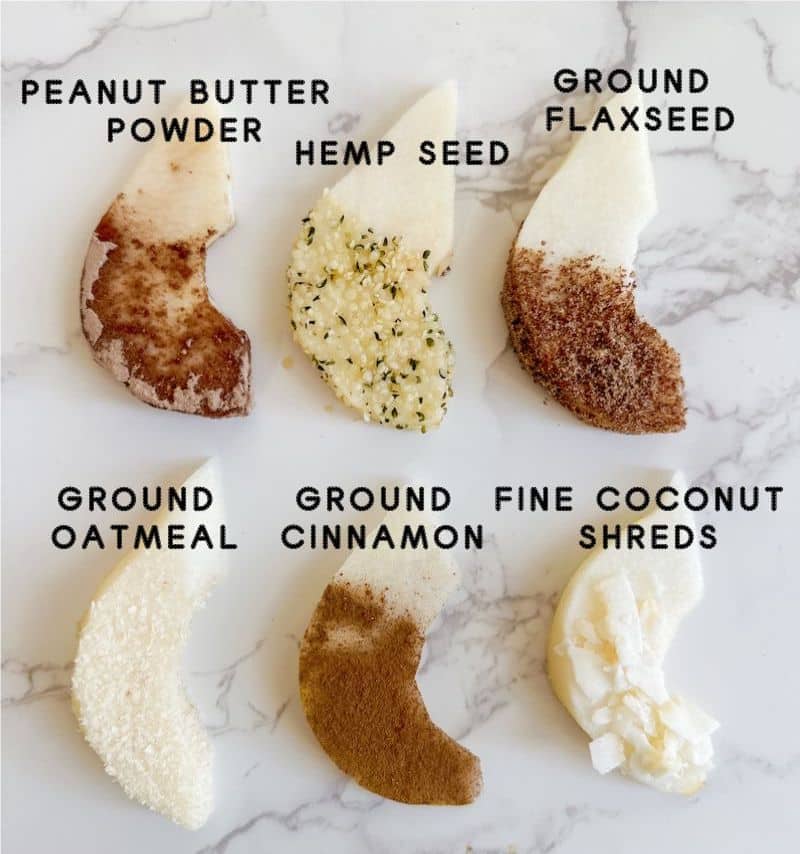Baby-Led Weaning Pears: How to Prepare and Serve
Whether your baby is starting baby-led weaning or you are sticking to traditional spoon feeding, pears are a wonderful first food for your little one. In this post I will explain how to safely prepare and serve pears to babies at each stage (6-9 months, 10-12 months, 12+ months), the health benefits of pears for babies, and a few fun baby-led weaning pear recipes! Read on to learn more.

Are Pears Safe to Serve to Babies?
For babies, 6 months of age and older, ripe pears are a great food to offer and do not pose any danger to infants if served appropriately. Avoid offering infants younger than 12 months firm pears with skin as this is a choking hazard. Further, it’s best to wait until your infant or toddler has a full set of teeth before offering firm pears with skin.
To check a pear for ripeness, leave the pear at room temperature daily. Check the neck of the pear for ripeness by gently pressing around the neck or stem. If the pear yields to pressure, it is ready to eat. If it is firm, continue to allow the pear to ripen by leaving it out at room temperature.
Are Pears Healthy for Babies?
Yes, pears are an excellent source of vitamin C, fiber, potassium, copper, and beneficial plant compounds depending on the color. Vitamin C helps babies absorb iron, which is a nutrient to focus on around 6 months of age. The fiber in pears helps babies develop a healthy gastrointestinal tract while reducing constipation – which is a common problem for babies at this age – and helps promote healthy gut bacteria.
Copper is an important mineral for immunity cholesterol metabolism, and nerve function, and potassium is important for heart health and muscle contractions.
The beneficial plant compounds are found in the skin of the pears, which is why it’s great to serve soft, ripe pears to babies with the skin on!
How to Serve Pears for Baby-Led Weaning (6-9 months, Palmar Grasp)
When offering solid foods to babies 6-9 months of age, you should prepare the food by using the palmar grasp method – meaning offering finger strip slices of food so that your baby can hold the food in the palm of his or her hand. Cut the pear into finger slices (about the size of your pinky finger). It’s okay if the slice is a bit longer than your pinky. Or, you may offer a pureed or smashed pear.
To offer a smashed pear, you should (1) peel the pair, (2) smash the pear with a fork until all big chunks are softened, and (3) serve with a spoon or allow your baby to self-feed with her hands. Self-feeding purees is a wonderful way for your infant to gain confidence in self-feeding and explore a variety of textures.
Side note: Always offer ONE FOOD at a time to ensure your baby is not allergic to the new foods. I recommend offering smashed pear first, and then finger slices rolled in one of the options below second.
A ripe pear will be slippery and possibly mushy, but that’s okay! To prevent the pear from slipping through your baby’s palmar grasp, try rolling the pear in:
- Ground cinnamon (may cause dermal rash if cinnamon gets on face)
- Ground flaxseed
- Ground oatmeal (potentially allergenic food)
- Hemp seed
- Finely ground coconut shreds
- Peanut butter powder (potentially allergenic food)
Again, if you try any of these options, always make sure your baby has tried the pear alone first. This could be a good way to introduce your baby to one of the second foods (flax, hemp, oat, peanut, etc.).

How to Serve Pears for Baby-Led Weaning (10-12 months, Pincer Grasp)
As your baby approaches 10 months, he or she will begin to develop the pincer grasp. With this grasp, your baby will be able to pick up small objects including pieces of foods (think: cheerios). For pears, you may now cut the ripe pear into small bite-sized pieces.
The benefit of the bite-sized pieces is that a ripe pear will now be easier for your baby to grap and place in her mouth – even if it is slippery.
From 10 months on, you may offer pear in the form of puree, finger slices, or bite-sized pieces.
How to Serve Pears for Baby-Led Weaning (12 Months and Beyond)
As your baby approaches his or her first birthday, they may begin smiling with a full set of teeth! If this is the case, your baby might be ready to eat a whole ripe pear. There is nothing cuter than a little one chomping on a whole piece of fruit. You are to be the best judge of when your child is ready to start eating whole fruit, like pear, and never leave your child unattended while eating.
On another note, if your baby has never taken to pear – perhaps she didn’t like the texture or the puree or became frustrated with the slippery finger slices – offering a whole pear might be a new exciting way to get your baby to accept this nutritious fruit.
What Type of Pear Should I Serve My Baby?
I always go with the Bartlett pears, as they are the juiciest and sweetest. Bartlett pears are in season from August to February. There are many other varieties of pears, try them all out and see which one you and your baby prefer.
Baby-Led Weaning Pear Recipes:
Pear Pancakes by, Lilly with Feeding Tiny Bellies
Pear Puree, by Stacey on My Kids Lick the Bowl
Banana Pear Oat Toddler Cookies, by Hope on Love Food Nourish
I hope this helps! If you’re interested in learning more about starting Baby-Led Weaning, check out this post 10 Tips for Successful Infant Feeding. Have a great day!
Written by Sheridan Glaske, MS, RDN, LD





